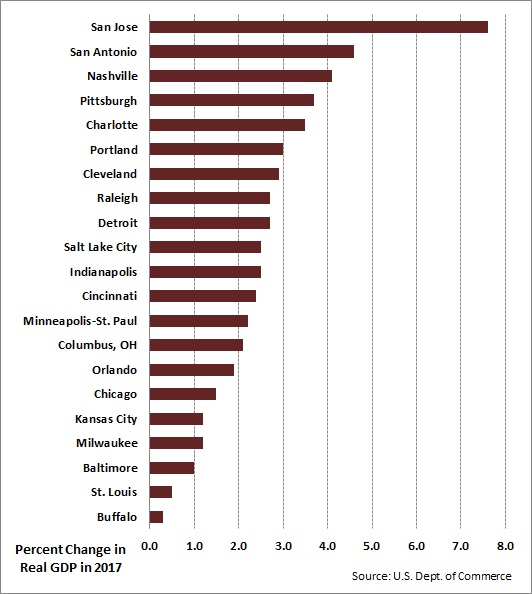Metro Milwaukee’s real gross domestic product increased 1.2 percent in 2017, a pace slower than more than 60 percent of other metro areas in the country, according to data from U.S. Department of Commerce.
The pace of growth in the region, which includes Milwaukee, Waukesha, Washington and Ozaukee counties, marked a slowdown from 2016, when its real GDP grew 1.7 percent. In 2015, the region’s economy contracted by 3.3 percent.
In addition to ranking 232nd out of 383 metro areas, Milwaukee only grew faster than three of the 20 other metro areas the Metropolitan Milwaukee Association of Commerce included in a 2015 study of similar regions.
Buffalo was the slowest growing of the comparable metros at just 0.3 percent. St. Louis, up 0.5 percent, and Baltimore, up 1 percent, also trailed Milwaukee. Chicago, up 1.5 percent, and Kansas City, up 1.2 percent joined Milwaukee in the bottom half of metro areas.
Nine of the regions included in the MMAC study were among the 100 fastest growing in the country, led by San Jose, up 7.6 percent, San Antonio, up 4.6 percent and Nashville, up 4.1 percent.
Nearly half of Milwaukee’s 1.2 percent increase came from manufacturing industries with durable goods contributing 0.37 percentage points and nondurable goods adding 0.2 points. Trade also contributed 0.26 points.
Milwaukee also saw some of the slowest growth in Wisconsin. Among metro areas entirely in the state, only Racine and Appleton had slower growth at 0.3 and 1.1 percent respectively.
For Racine, it was the first year with growth in real GDP since 2012 and just the third such year since 2005. The metro’s GDP in 2017 was still $844 million lower than it was in 2005 in comparable dollars.
The fastest growing metro economies in the state were Eau Claire, up 3 percent, Sheboygan, up 2.9 percent and Fond du Lac, up 2.8 percent.
Read more economic data reports at the BizTracker page.
